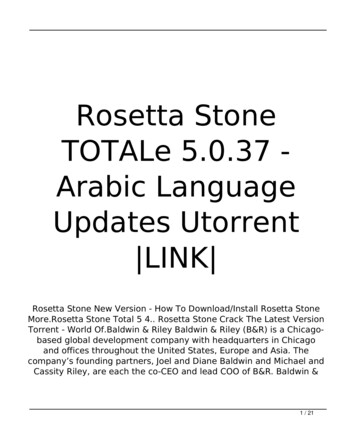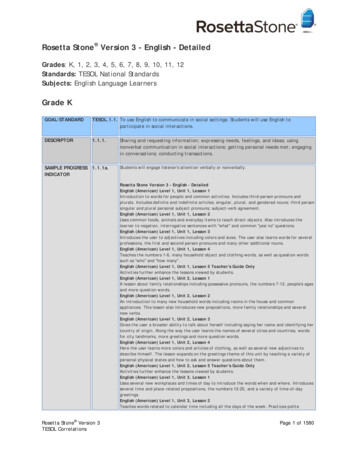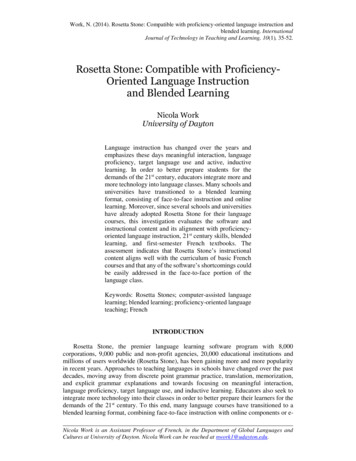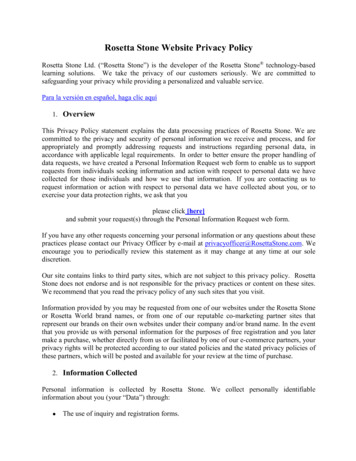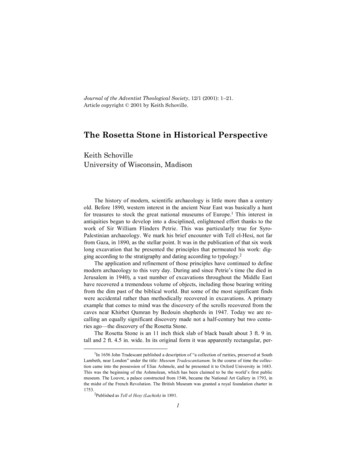
Transcription
Journal of the Adventist Theological Society, 12/1 (2001): 1Ð21.Article copyright 2001 by Keith Schoville.The Rosetta Stone in Historical PerspectiveKeith SchovilleUniversity of Wisconsin, MadisonThe history of modern, scientific archaeology is little more than a centuryold. Before 1890, western interest in the ancient Near East was basically a huntfor treasures to stock the great national museums of Europe.1 This interest inantiquities began to develop into a disciplined, enlightened effort thanks to thework of Sir William Flinders Petrie. This was particularly true for SyroPalestinian archaeology. We mark his brief encounter with Tell el-Hesi, not farfrom Gaza, in 1890, as the stellar point. It was in the publication of that six weeklong excavation that he presented the principles that permeated his work: digging according to the stratigraphy and dating according to typology.2The application and refinement of those principles have continued to definemodern archaeology to this very day. During and since PetrieÕs time (he died inJerusalem in 1940), a vast number of excavations throughout the Middle Easthave recovered a tremendous volume of objects, including those bearing writingfrom the dim past of the biblical world. But some of the most significant findswere accidental rather than methodically recovered in excavations. A primaryexample that comes to mind was the discovery of the scrolls recovered from thecaves near Khirbet Qumran by Bedouin shepherds in 1947. Today we are recalling an equally significant discovery made not a half-century but two centuries agoÑthe discovery of the Rosetta Stone.The Rosetta Stone is an 11 inch thick slab of black basalt about 3 ft. 9 in.tall and 2 ft. 4.5 in. wide. In its original form it was apparently rectangular, per1In 1656 John Tradescant published a description of Òa collection of rarities, preserved at SouthLambeth, near LondonÓ under the title: Museum Tradescantianum. In the course of time the collection came into the possession of Elias Ashmole, and he presented it to Oxford University in 1683.This was the beginning of the Ashmolean, which has been claimed to be the worldÕs first publicmuseum. The Louvre, a palace constructed from 1546, became the National Art Gallery in 1793, inthe midst of the French Revolution. The British Museum was granted a royal foundation charter in1753.2Published as Tell el Hesy (Lachish) in 1891.1
Journal of the Adventist Theological Societyhaps with a rounded top.3 When it was found the top corners and the bottomright corner were missing. A careful search for the missing pieces at the time ofdiscovery proved fruitless, probably because the damage occurred prior to thetransfer of the stone into secondary use where it was found.The DiscoveryThe Rosetta Stone was discovered by chance in August,4 1799, near thetown of Rosetta (Rashid) in the western delta of Egypt. Rosetta is located somethirty miles (48 km.) northeast of Alexandria; Cairo lies slightly more than onehundred miles to the south. The town gives its name to one of the major mouthsof the Nile River as it empties into the Mediterranean Sea a few miles from thesite of discovery. (The channel is also known as the Bolbinitic branch of theNile.) The Rosetta mouth lies to the west of the second main mouth, the Damietta.The discovery was remarkable because the stone was inscribed in two languagesÑGreek and EgyptianÑwritten in three scripts, hieroglyphic, demotic,and Greek. It was to be the key to unlock the reading of the mysterious writingof ancient Egypt, knowledge that had slipped into oblivion over a millenniumearlier. But that is enough about the discovery for the moment; we will return toit later. For now, let us hear the rest of the story, in order to appreciate the significance of the discovery.The Demise of Ancient Egyptian Writing.We celebrate the discovery of the Rosetta Stone and the subsequent decipherment of hieroglyphics because human ability to read the ancient script hadbeen lost. This was a part of the demise of the glory that once was Egypt, aprocess that was long and drawn out. During most of the biblical period we callIron Age II, spanning the period after SolomonÕs death and through the dividedkingdom era, Egypt was experiencing the Third Intermediate Period (ca.1085Ð664 B.C.). Dynasties 21 through 25 were ruled by non-Egyptian pharaohsÑparticularly Libyan (including Sheshonq I) and Sudanese.5 It was in thisera that the demotic form of Egyptian writing developed from the hieratic. Thisabbreviated and cursive form of writing was used for the needs of daily life.Dynasty 26 (664Ð525 B.C.), the Saite dynasty, saw a restoration of rule toEgyptians, including Pharaoh Necho II. But Assyrian domination was a part of3Cf. Budge, The Rosetta Stone, 35. Rounded tops with sculptured reliefs have been found onthe tops of stelae dedicated to Ptolemy II, Ptolemy III, and Ptolemy IV. BudgeÕs translation of theGreek inscription appears at the end of this paper.4Some sources date the discovery in July (e.g., Carol Andrews, The British Museum Book ofThe Rosetta Stone, 12, puts the discovery in Òmid-JulyÓ) while others date it to August (so, no lessan authority than E. A. Wallis Budge in The Rosetta Stone, 20: ÒThere is no doubt that it was foundin August, 1799 .Ê.Ê. Ó).5Cf. Hallo and Simpson, The Ancient Near East: A History, Ch. XII.2
Schoville: The Rosetta Stone in Historical Perspectivethe times, and Egypt was but Òa broken reed,Ó to echo Isaiah 36:6. Necho was atleast partially responsible for the death of King Josiah of Judah, shortly beforethe conquest of Nebuchadnezzar and the Babylonian Exile of the Judeans. Withthe Persian defeat of Babylon, Cambyses conquered Egypt and it became a satrapy of Persia. Persian domination did not signal the termination of Egyptianculture, but the influence of outsiders slowly eroded the dying culture. Greekinfluence and a Greek presence had existed in the delta region since at least themid-sixth century B.C.6, but the arrival of Alexander the Great in 332 B.C.brought Egypt into the final phase of its ancient existence, and it is in theGraeco-Roman period that the arrival of Christianity ultimately snuffed out theancient religious practices and the related knowledge of its writing system. Faintvestiges of demotic were to survive in the form of Coptic writing, but notenough to keep alive a memory of the ancient scripts.7In Egypt, following the death of Alexander in Babylon in 323 B.C., the Macedonian general, Ptolemy of Lagos, became the ruler. Realizing the importanceof maintaining an expedient relationship between his rule and the power of theEgyptian religious leaders, he and his successors were careful to cultivate thefriendship of the all-powerful priesthood. As Cleator has noted, ÒTo this end,rich endowments of grain and money were made to various temples, and otherswere restored and rebuilt; many new shrines and altars were founded; and enemies of the priests were suppressed. In these most favorable circumstances, it ishardly surprising that the accredited representatives of the high gods enthusiastically endorsed the rule of the intruders, whom they proceeded to deify in accordance with time-honored practice.Ó 8 And thereby we find our connection to theRosetta Stone. Following earlier Ptolemaic exemplars, the Egyptian priests decreed Ptolemy V a god on the occasion of his coronation on March 27, 196 B.C.,and the decree was engraved on what we now know as the Rosetta Stone, likelyfor permanent display in a nearby temple.9As far as we know, the last hieroglyphic inscription was cut into stone on atemple at Philae in A.D. 394. This was just a decade after the Byzantine emperor, Theodosius I (A.D. 379Ð95), issued an edict establishing Christianity asthe religion of the empire and closing the temples dedicated to the old gods, andwith them went the associated scribal schools. Ancient Egyptian writing wasdead.6Cf. Hallo and Simpson, 292; cf. Discovering Ancient Egypt, 171.Coptic consists of the Greek alphabet plus seven characters derived from the demotic script torepresent sounds in the contemporary Egyptian language but not in the Greek, Coptic is a fossillanguage used for chanting and praying in Coptic services. Everyday use of the language gave wayto Arabic in the 16th century. Its linguistic and literary study among scholars can be traced to thepioneering work of Athanasius Kircher in A.D. 1636.8P. E. Cleator, Lost Languages, 31.9Champollion thought the temple stood in Bolbitine, a town in the area no longer in existencebut referred to in Gk. sources (cf. Budge, 20).73
Journal of the Adventist Theological SocietyThe Enigma of Egyptian Hieroglyphs Before the 19th CenturyBoth the Greeks and the Romans were fascinated by the ancient and esoteric culture of Egypt. Among those who traveled to and left a record of theirobservations was Òthe father of history,Ó Herodotus of Halicarnassus (c.490Ð430 B.C.). He visited Egypt c. 450, when the Persians ruled. In the midfirst century B.C., Diodorus Siculus was in Egypt. The first of his twelve volumes of Universal History was devoted to Egypt, but he also depended upon theaccounts of other visitors from earlier times, particularly Herodotus.Manetho, an Egyptian priest, wrote his Aegyptiaca (History of Egypt) inGreek during the reign of Ptolemy II Philadelphus (283Ð246 B.C.), the sameruler who enabled the translation of the Pentateuch into Greek. Only fragmentsof ManethoÕs work survived in the writings of Flavius Josephus, Sextus Africanus, Eusebius (A.D. 320), and George called Syncellus (ca. A.D. 880).ManethoÕs chronology of the pharaonic dynasties was destined to assist Champollion in his decipherment of Egyptian royal names.10Strabo, the famous Roman geographer, visited Egypt in 25 B.C. Of his seventeen books about the Roman world, the last gives an account of EgyptÕs geography, along with information on tombs, pyramids, temples, and religious andhistorical facts, focused mainly on Alexandria and the Delta. A century later,Pliny the Elder (A.D. 23Ð79) wrote his Historia Naturalis. He provides an earlyreference to the Sphinx at Giza as well as to Egyptian obelisks erected in Rome.He, Herodotus, and Diodorus also described the peculiar Egyptian custom ofmummification. Another famous classical writer was Flavius Josephus. We cannot be certain that he ever visited Egypt, although it is unlikely; nevertheless, hewas an important resource used by European intellectuals inquisitive aboutmatters Egyptian during the Renaissance. These classical authors provide aunique view of Egypt and, despite their shortcomings, they remained the mostreliable source for ancient Egypt until the decipherment of hieroglyphs usheredin the modern age of Egyptology.The Greeks and the Romans were deeply moved by the evident wisdom ofancient Egypt, seen in the grandeur of its monuments. And they were impressedby the mysterious picture-writing of Egypt, which they believed containedwithin its symbols secret mysteries and profound truths. Despite this interest, weknow of no Greek who could read hieroglyphics.As my colleague Michael V. Fox has noted,The Greeks . . . were fascinated by hieroglyphics, though they didnÕt bother tolearn them, or even to learn what they really were. For they were quite sure thatthey knew what the hieroglyphics were, namely symbolical or allegorical writing.Ê.Ê.Ê. Plotinus (3rd c. A.D.), the founder of Neo-Platonism, gave a tremendous boost to this notion of hieroglyphics, a boost that carried it right throughthe Middle Ages and Renaissance to the 19th century. The Neoplatonists had no10Discovering Ancient Egypt, 13f.4
Schoville: The Rosetta Stone in Historical Perspectiveinterest in discursive reasoning. They wanted to get right to the heart of knowledge by direct experience of the truth itself. Plotinus thought that the Egyptianshad acquired a way of writing with pictures which were not merely representations [of language] but were endowed with symbolic qualities by means ofwhich they revealed to the initiatedÑthe very essence and substance of things.The Neoplatonists saw the hieroglyphs as sermons in stones, in the most literalsense of the expression.11And there was some truth to this: Ò[In its final stages] .Ê.Ê. the language itself hadbecome almost incredibly convoluted, abstruse and deliberately cryptographic.Ó12 As Jan Assmann observes,Until the Late Period, cryptography is a very rare variant of hieroglyphic, usedpredominantly for aesthetic purposes, to arouse the curiosity of passers-by. Butin the Greco-Roman period, an age of foreign domination, the methods ofcryptography were integrated into the monumental script of hieroglyphics; thiscreated enormous complexity and turned the whole writing system into a kindof cryptography.13The combination of Egyptian scribal cryptography and Neo-platonist inclinations was destined to be a stumbling block through many generations of thosewho sought to understand the wisdom of ancient Egypt.Following Plotinus, near the close of the fourth century A.D., Horapollowrote in the Egyptian language (probably Coptic) a two-part treatise on the hieroglyphs. This was translated into Greek by someone named Philippus. A traveler, Buondelmonte, discovered the book for Europeans on the Aegean island ofAndros in 1419.14 Budge characterizes HorapolloÕs ÒHieroglyphikaÓ thus:The first book contains evidence that the writer had a good knowledge of themeanings and uses of Egyptian hieroglyphs, and that he was familiar with inscriptions of the Ptolemaic and Graeco-Roman periods. In the second bookthere are many absurd and fanciful statements about the meanings and significations of Egyptian hieroglyphs, and these are probably the work of the unknown PHILIPPUS, who [ .Ê.Ê. ] was ignorant of the phonetic values of thecharacters he described.15Hieroglyphika was destined to have a long and profound effect on westernideas about Egyptian thought and writing, an effect that continued in some circles even after the decipherment of the ancient system of writing. Rather thanrelating the signs to phonetics, the book related them to ideas, for example:To indicate a man who has never travelled they paint a man with a donkeyÕs head.11Unpublished lecture, ÒThe Rise and Fall of Egyptian HieroglyphsÓ; my thanks to Prof. Foxfor these observations.12John Anthony West, The TravelerÕs Key to Ancient Egypt, 26.13Moses the Egyptian, 108.14The Story of Archaeological Decipherment, 11.15The Rosetta Stone, 181. For the Gk. text with English trans., Budge directs his readers to A.T. Cory, The Hieroglyphics of Horapollo Nilous, London, 1840.5
Journal of the Adventist Theological SocietyFor he never knows or listens to accounts of what happens abroad.They paint a hand to show a man who is fond of building. For the hand iswhat carries out work.16Likewise, a crocodile represented evil; a hare indicates what is open, because the hare always has its eyes open. The eye signifies a god or divine justice, that is, the ever and all-seeing eye. However, a hawk could also represent agod, because the hawk is fecund or long-lived, or it symbolized the sun, becauseit excels all other birds in sharpness of sight, because of the rays of its eyes. Afish shows the lawless or the abominable, because its flesh is hated and an objectof disgust in the temples. For every fish is a purgative, and they eat each other.On the other hand, the vulture is used to indicate motherhood, because alone ofall the animals there is no male vulture, but when the female would generate, sheopens her vulva to the wind and is impregnated by the north wind.17Such was the legacy of the classical world in this respect, largely lost untilits rediscovery in the 15th, 16th, and 17th centuries. However, between the 5th andthe 15th centuries, a long hiatus in interest in ancient Egypt ensued, largely dueto the pervasive influence of Christianity. Early on the spread of Christian culture in the Byzantine period affected the view of EgyptÕs past. Egypt representedthe pagan past. The ancient monuments were often disdained and sometimesdefaced. When noted, they were interpreted in terms of biblical events. Thencame the Arab conquest in the 7th century A.D. This aroused no interest in theremnants of ancient Egypt among the conquerors. By this time, too, the nativepopulation had very little memory of that long-departed civilization, and none ofthem could read the hieroglyphs. The Islamic conquerors had their own agendaand were little interested in the ancient monuments which, because of their massive concept and scale, they believed had been constructed by giants or magicians.Few Europeans traveled to Egypt in the centuries before the Crusades. Anoccasional non-Muslim traveler did visit Egypt, however, and particularly noteworthy was Benjamin ben Jonah of Tudela in Navarre, who made the journey inA.D. 1165Ð71. He was the first to note that the annual flood of the Nile was dueto the rains that fell on the mountains of Abyssinia. There was also a Muslimdoctor from BaghdadÑAbdÕel-LatifÑwho taught medicine and philosophy inCairo and who visited the pyramids of Giza and the Sphinx. His account, however, had no influence on later European investigations because it was nottranslated from the Arabic until the early 19th century.18The Renaissance turned intellectual attention to classical Rome and Greece,and also to the even more ancient wisdom of Egypt, just as classical antiquityhad held that wisdom in awe. As Pope has noted,16The Story of Archaeological Decipherment, 18Ð19.Drawn from illustrations from Fox.18Discovering Ancient Egypt, 15.176
Schoville: The Rosetta Stone in Historical PerspectiveThis great confidence in the virtues of Egyptian writing existed despite the factthat scarcely anybody had ever seen any. Cyriac of Ancona had brought backfrom Egypt one or two drawings. There were a few inscribed fragments of obelisks lying partly visible in back quarters of Rome; that was the sum of whatwas available. Nevertheless, imagination could supply the deficiency, and itdid. The first pseudo-hieroglyphs to be printed and published were the modernones of Francesco Colonna, a learned, allegorical novelist .Ê.Ê.Ê. 19ColonnaÕs Hypnerotomachia Poliphili (1499) included pseudo-hieroglyphs suchas those in a circular medallion, divided vertically by a staff on which two serpents are intertwined. In the upper half on either side, two elephant posteriorsare expanding from small objects; on the lower half on either side, two forehalves of elephants are descending into small objects. On the left side is a censorwith burning fire; on the right side is a basin of tranquil water. The whole is tobe interpreted: ÒConcord makes little things big; discord makes great thingssmall.Ó20 Such an exercise was possible because hieroglyphs were thought of assymbols of wisdom to be understood allegorically rather than as elements oflanguage.Pierius Valerians, Apostolic Prothonotary to Pope Clement VII, published in 1556 a comprehensive study entitled The Hieroglyphs, or a Commentary on the sacred letters of the Egyptians and other peoples. He wrote theequivalent of fifty-eight chapters on the subject. The first thirty-one dealt withanimals; the remainder treated parts of the human body, man-made artifacts, andplants. In the 1561 edition, one of his self-made hieroglyphs is of a stork headattached to a bovine lower-leg and hoof. Its meaning: Impietati praelata Pietas,that is, ÒDevotion over Selfishness.Ó21 Others followed this pattern of creatinghieroglyphs never seen by an Egyptian eye. The interest in hieroglyphs had onepositive result. A number of obelisks that had been brought to Rome and erectedin the days of the empire had fallen and lain in disuse, partially obscured by accumulated dirt and debris. As Pope reports, ÒBetween 1582 and 1589 no lessthan six obelisks were either re-sited or put up again for the first time since antiquity. One important consequence was that in future engravings of obelisks,hieroglyphic inscriptions had to be very much more accurate.Ó22 And the interestin hieroglyphs continued, but unfortunately dominated by the view that theyinherently held Òabstract moral and philosophical ideas of pronounced significanceÓ23 rather than specific language. Nicolao Caussin wrote a work on Egyptian wisdom in the early 17th century in which he defined a hieroglyph as Òanimage or figure arbitrarily agreed on by men to express a particular meaning,19The Story of Archaeological Decipherment, 23.After Fox.21The Story of Archaeological Decipherment, 27, fig. 13.22Ibid.23C. Aldred, The Egyptians, 15.207
Journal of the Adventist Theological Societywhich was employed by the philosophers of Egypt instead of letters.Ó24 A Jesuitpriest, Athanasius Kircher, is remembered for his work on the Coptic language,but he published voluminously about hieroglyphs following the presuppositionsof his predecessors25The end of the Crusades had sparked a renewed European interest in theNear East, including Egypt, thanks to the accounts of returning Crusaders. Ofeven greater importance was the fall of Constantinople to the Turks in A.D.1453, bringing to the west an influx of Byzantine scholars, along with manymanuscripts by classical Greek and Roman authors. The time was at hand fornew ways of thinking embodied in the Renaissance.Other influences were also at work. In 1517 the Turks gained control ofEgypt. They signed treaties with France and Catalonia, permitting their tradersto operate in Egypt and even providing religious protection. Increasing numbersof diplomats and merchants traveled to the Near East, followed by pilgrims tothe holy sites and individuals inquisitive about ancient monuments. Greaterfreedom to travel was coupled with the intellectual ferment fostered by the Renaissance, and an interest in acquiring antiquities and curiosities developedamong wealthy collectors. To this demand the Egyptian entrepreneurs enthusiastically responded.One peculiar development in Europe was an interest in the presumed medical benefits of powdered mummies! In the 16th and 17th centuries, it was one ofthe most common ingredients found in the shops of European apothecaries. Andin 1658 the philosopher Sir Thomas Browne commented, ÒMummy is becomeMerchandise, Mizraim cures wounds, and Pharaoh is sold for Balsams.Ó26 Butthe use of mummy as a medicinal ingredient seems to have occurred as early asA.D. 1100.The international trade in mumia flourished, with Alexandria as the mainexport center. Complete mummies and packages of mummy tissue wereshipped, and soon demand exceeded supply. In 1834 the surgeon Thomas Pettigrew wrote, in his History of Mummies, ÒNo sooner was it credited that mummyconstituted an article of value in the practice of medicine than many speculatorsembarked in the trade; the tombs were sacked, and as many mummies as couldbe obtained were broken into pieces for the purpose of sale.Ó27The Egyptian authorities had to curb the export of mummies, but this onlyexacerbated the problem of supply, and that led to fraud. Pettigrew explains how24See The Story of Archaeological Decipherment, note 16, 193. CaussinÕs de symbolica Aegyptiorum sapientia was published in Cologne in 1631.25Prodomus Coptus sive Aegyptiacus, Rome, 1636; Lingua Aegyptiaca restituta, Rome, 1643;Obeliscus Pamphilius, Rome, 1650; Oedipus Aegyptiacus, Rome, 1652Ð54; Polygraphia nova etuniversalis, Rome, 1663; Obelisci Aegyptiaci nuper inter Isaei Romani rudera effossi interpretatiohieroglyphica, Rome, 1666 (after The Story of Archaeological Decipherment, 208.26Rosalie, Discovering Ancient Egypt, 16.27Op. cit.8
Schoville: The Rosetta Stone in Historical PerspectiveGuy de la Fonteine of Navarre investigated the mummy trade in Alexandria in1564. When he looked into the stock of mummies held by the chief dealer there,he found that the supply was augmented by preparing the bodies of the recentlydead, often executed criminals, by treating them with bitumen and drying themin the sun to produce mummified tissue which was then sold as genuine mumia.Later in the 18th century, when the nature of such supplies was eventually revealed to authorities, traders were imprisoned, a tax was levied, and it becameillegal to export mummies from Egypt.28As David notes, ÒThe actual benefits of the ingredient were disputed. Onthe one hand, it was used to treat amongst other ailments, abscesses, fractures,concussion, paralysis, epilepsy, coughs, nausea and ulcers. It also received royalapproval when King Francis I of France reputedly always carried with him somemumia mixed with pulverized rhubarb to treat his ailments. However, accordingto the physician Ambrose ParŽ, writing in 1634, it had no beneficial effects:ÔThis wicked kinde of drugge, doth nothing help the diseased . . . it also inferresmany troublesome symptomes, as the paine of the heart or stomake, vomiting,and stinke of the mouth.Õ The strict measures introduced to curb the mummytrade did in fact reduce the worst excesses, but the ingredient continued to be indemand, and was still in use in medicines in 19th century Europe.29The flow of travelers to the Near East and to Egypt engendered anotherform of trade which we mentioned above. Some travelers began to realize thatEgyptian antiquities could be sold to wealthy patrons in Europe at great profit.Among those hungering for acquisitions were nobility and royalty, none moreenthusiastically than the Kings of France. Embassies and consulates began toengage in duties other than diplomatic, using local agents to seek out attractiveantiquities. Gradually, foreign collectors also sought permission from the Turkish rulers in Egypt to carry out their own excavations, in order to acquire andremove inscriptions, statuary and tomb goods. This in turn led to internationaljealousy and rivalry between the different factions who were all anxious to supply the most desirable antiquities for their wealthy clients. In time some of thegreat private collections would become the foundation for national collections tobe housed in the Louvre in Paris, the British Museum in London, etc.By 1798, when Napoleon Bonaparte went to Egypt in search of an empire,the foundations for the study of Egyptology had already been laid: the extensivejourneys throughout the country had enabled travelers to discover all the principal monuments above ground, and in many cases these were already accuratelyidentified with ancient sites. Some excavation had also been carried out, revealing burials at Sakkara and Thebes. The rush to obtain antiquities for great collections abroad had already led to the destruction of monuments and archaeological material, but there were now extensive groups of objects outside Egypt28Op. cit.Op., cit., 16-17.299
Journal of the Adventist Theological Societywhich could be studied by scholars. Interesting and increasingly accurate contemporary accounts of journeys also were being written, and these augmentedthe Classical sources and replaced the older, derivative travel books.I have attempted to trace briefly the history of interest in and knowledge ofancient Egypt and its hieroglyphs prior to the discovery of the Rosetta Stone andsubsequent developments. I want to add the observations of John A. Wilson:Contrast changes in Europe and the US, where the Industrial Revolution andthe American and French revolutions meant irrepressible change, and Egypt,still steeped in the atmosphere of the Middle Ages. A nominal dependency ofthe Turkish Sultan, but ruled with arrogant brutality by foreign mercenaries, theMamelukes, Egypt was caught in the torpor of the times and was of little interest to either Europeans or Americans. Any knowledge about Egypt was basedon the Bible and the classical authors, supplemented by a few fantastic books oftravel. Ideas about Egypt had a large factor of the preposterous. The fertile mudof the Nile after the annual inundation was thought to produce life spontaneously. Said Lepidus in ShakespeareÕs Antony and Cleopatra, ÒYour serpent ofEgypt is bred now of your mud by the operation of your sun. So is your crocodile.Ó Dried and pulverized mummy was believed to be an effective drug inmedicine.Ê.Ê.Ê. And European painters in oils used a pigment called Òmummy,Ómade of bitumen and animal remains from Egyptian tombs, because it was reputed not to crack on the canvas.Equally fantastic were the ideas of the Europeans about the Egyptian hieroglyphs. Generally speaking, ancient Egypt was both remote and incomprehensible; by definition, hieroglyphic was priestly carving, and priests are always suspected of cabalistic mysteries. Therefore, the hieroglyphs must be supercharged with secret symbolism; they could not be read as a Westerner mightread Arabic or Chinese. About 1762 a distinguished British physician, WilliamStukeley, the Secretary of the Society of Antiquaries, wrote:The hieroglyphics of the Egyptians is a sacred character; that of theChinese is civil or a common way of writing.Ê.Ê.Ê. The characters cuton Egyptian monuments, are purely symbolical. They are nothingthan hymns & invocations to the deity.Ê.Ê.Ê. To give a few instances.A feather so often appearing, signifyÕs sublime. An eye is providence.Ê.Ê.Ê. A boat, the orderly conduct of providence in the government of the world. A pomegranate imports fecundity, from the multitude of its seeds.Ê.Ê.Ê. I believe the true knoledg of the hieroglyphicswas immersed in extremest antiquity. So that if any skill of interpreting them, remainÕd with the priests, to the time of Cambyses; after that time, the just understanding of them was lost.Ê.Ê.Ê. The perfectknoledg of Ôem is irrecoverable, with the most antient preists [sic]With such an attitude of mind among literate people, it is not surprisingthat there was no initiative to find the key to hieroglyphic and that the scholarlyworld was slow to accept ChampollionÕs decipherment in 1822.30Wilson paints the picture a little too black, h
The Rosetta Stone was discovered by chance in August,4 1799, near the town of Rosetta (Rashid) in the western delta of Egypt. Rosetta is located some thirty miles (48 km.) northeast of Alexandria; Cairo lies slightly more than one hundred miles to the south. The town gives its name to one of the major mouths


